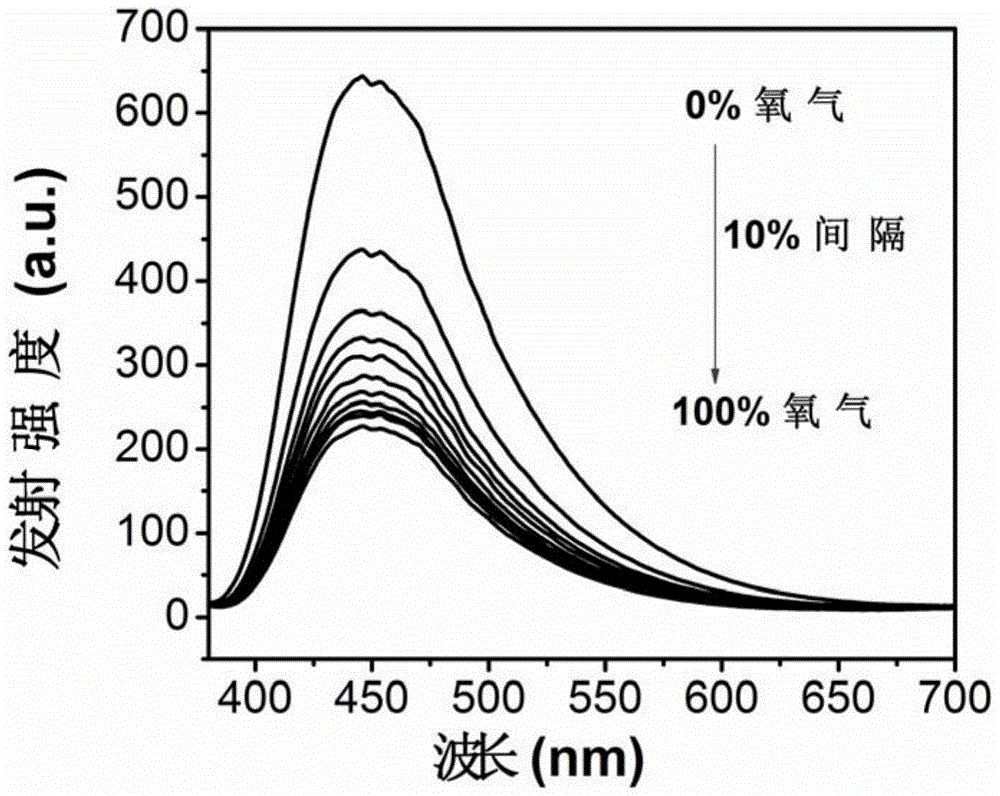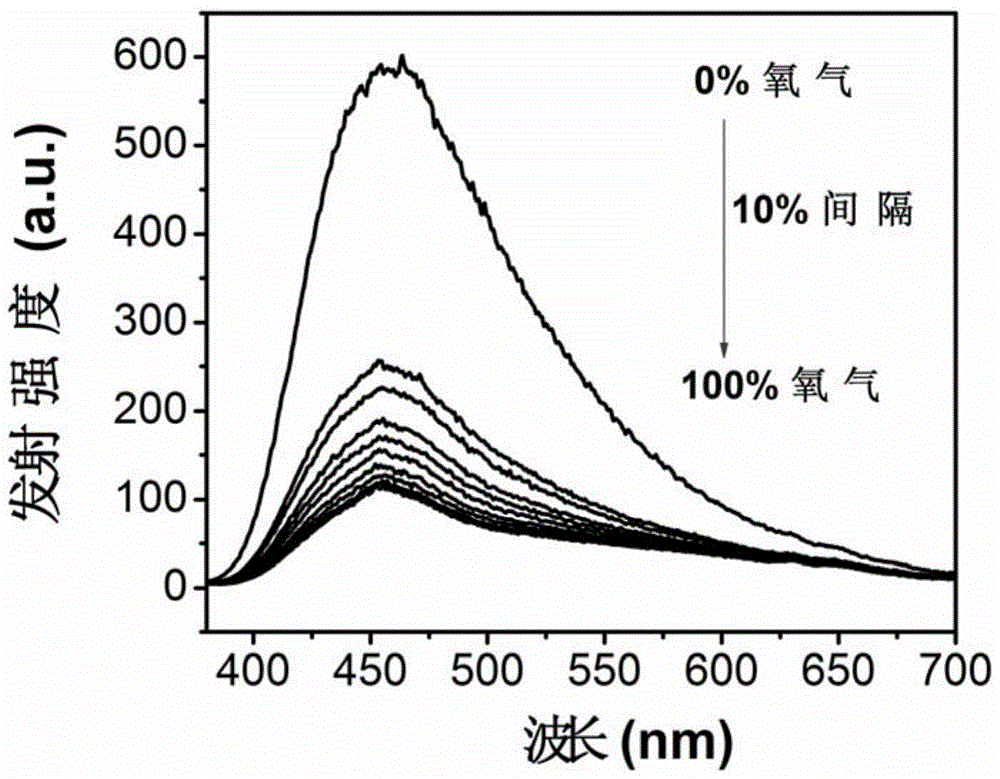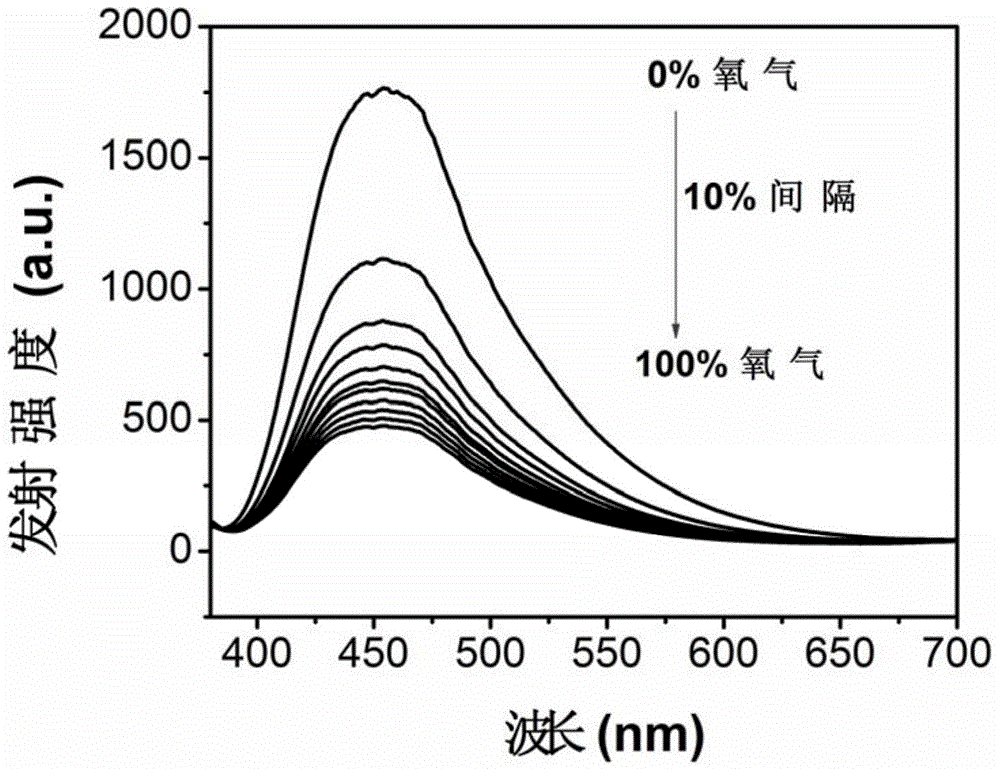Fluorescent carbon dot/mesoporous molecular sieve composite luminescent material as well as preparation and application of fluorescent carbon dot/mesoporous molecular sieve composite luminescent material
A technology of mesoporous molecular sieves and fluorescent carbon dots, applied in the fields of luminescent materials, fluorescence/phosphorescence, analytical materials, etc., can solve the problems of production and application limitations, high price of precious metals, and achieve short time consumption, high sensitivity and selectivity, and low cost. Effect
- Summary
- Abstract
- Description
- Claims
- Application Information
AI Technical Summary
Problems solved by technology
Method used
Image
Examples
Embodiment 1
[0035] Example 1: Preparation of carbon dots / MCM-41 composite luminescent material
[0036] (1) Preparation of silane-functionalized fluorescent carbon dots: Add 30mL of silane coupling agent KH-602 into a 100mL three-necked flask, degas with nitrogen for 10 minutes, and heat to 240°C. Quickly add 1.5g of anhydrous citric acid while stirring, take it out after 3 minutes of constant temperature reaction, and cool it down to room temperature naturally. After the crude product is purified three times with petroleum ether, the final silane-functionalized fluorescent carbon quantum dots are obtained;
[0037] (2) Preparation of inorganic carrier mesoporous material MCM-41: can be obtained by referring to literature methods (C.T.Kresge, M.E.Leonowicz, W.J.Roth, J.C.Vartuli, J.S.Beck, Nature, 1992,359,710; J.S.Beck, J.C.Vartuli, W.J.Roth, M.E.Leonowicz, C.T.Kresge, K.D.Schmitt, C.T.-W.Chu, D.H.Olson, E.W.Sheppard, S.B.McCullen, J.B.Higgins, J.L.Schlenker, J.Am.Chem.Soc.1992,114,10834...
Embodiment 2
[0039] Example 2: Preparation of carbon dots / MCM-48 composite luminescent material
[0040] (1) Prepare silane functionalized fluorescent carbon dots by the method of Example 1;
[0041] (2) Preparation of inorganic carrier mesoporous material MCM-48: it can be obtained by referring to literature methods (D.Zhao, Q.Huo, J.Feng, B.F.Chmelka, G.D.Stucky, J.Am.Chem.Soc.1998,120, 6024; J.Xu, Z.H.Luan, L.Kevan, Chem.Mater, 1998, 10, 3690-3698), the specific steps are: according to TEOS: CTAB: NaOH: H 2O=1:0.6:0.47:65 ratio, weigh 10.95g cetyltrimethylammonium bromide (CTAB), dissolve it in 59.1mL deionized water, then add 0.94g NaOH, and maintain the system at 35°C Stir at constant temperature for a period of time to dissolve it, slowly add 9.7mL tetraethyl orthosilicate (TEOS), and continue stirring for 4 to 5 hours. Move it into a polytetrafluoroethylene-lined reactor, crystallize at 100°C for 48h, filter, wash with deionized water, and dry at 60°C for 12h. Put it into a muffl...
Embodiment 3
[0043] Example 3: Preparation of carbon dots / SBA-15 composite luminescent material
[0044] (1) Prepare silane functionalized fluorescent carbon dots by the method of Example 1;
[0045] (2) Preparation of inorganic carrier mesoporous material SBA-15: It can be obtained according to the literature method (B.F.Lei, L.Wang, H.R.Zhang, Y.L.Liu, H.W.Dong, M.T.Zheng, X.H.Zhou, SensActuatorsBChem.2016,10,1016) , the specific steps are: Weigh 6g of P123 into a round bottom flask, add 225mL of a mixture containing 180mL of 2mol / L hydrochloric acid and 45mL of deionized water, stir in a water bath at 35°C until it becomes clear, and add 13.8mL of orthosilicic acid dropwise Ethyl ester, kept stirring at 25°C for 24h. Put it into a polytetrafluoroethylene reactor lined with water heat treatment at 100°C for 48 hours, take it out after cooling, filter it with suction, and wash it repeatedly with deionized water for 5 times and once with ethanol, and dry the obtained powder in an oven at ...
PUM
 Login to View More
Login to View More Abstract
Description
Claims
Application Information
 Login to View More
Login to View More - R&D
- Intellectual Property
- Life Sciences
- Materials
- Tech Scout
- Unparalleled Data Quality
- Higher Quality Content
- 60% Fewer Hallucinations
Browse by: Latest US Patents, China's latest patents, Technical Efficacy Thesaurus, Application Domain, Technology Topic, Popular Technical Reports.
© 2025 PatSnap. All rights reserved.Legal|Privacy policy|Modern Slavery Act Transparency Statement|Sitemap|About US| Contact US: help@patsnap.com



